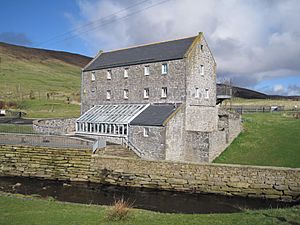Weisdale Mill facts for kids
Weisdale Mill is an important old building in the village of Weisdale, Shetland, Scotland. It used to be a watermill, which is a mill that uses water power to grind grain. The mill is found near the Weisdale Voe, a narrow inlet of the sea, on the west side of the island. It's about a twenty-minute drive from Lerwick, the main town in Shetland.
Contents
History of Weisdale Mill
Weisdale Mill was built in 1855. It was the biggest corn mill in Shetland. A corn mill grinds grains like oats and corn into flour or meal. Around the year 1900, old maps called it the Mill of Kergord.
A Busy Working Mill
Weisdale Mill was very busy for many years. It operated until the early 1930s. Farmers and crofters (small-scale farmers) traveled from far away to have their oats and corn ground. People often walked long distances with their crops. They would leave their grain at the mill and pick up the flour later. Some crofters even came by boat up the Weisdale Voe. They would then walk the short distance to the mill.
From Mill to Butcher Shop
In 1936, a local farmer named Tony Anderson bought the mill. He changed it into a butcher shop. The basement of the mill, where the cafe is now, was used for preparing meat. The ground floor became the butcher shop itself. The top floor was used for storage. People often used it to salt sheepskins before selling them.
The butcher shop was very busy, especially during World War II. Many soldiers were stationed nearby at Scatsta. Tony Anderson also had a large butcher van. This van visited many areas of Shetland every day, selling beef and lamb.
A Wartime Incident
During World War II, the mill was reportedly hit by enemy fire. Some bullets came through the back door, which was open at the time. Luckily, no one was hurt during this incident.
Weisdale Mill Today
The building stopped being a butcher shop in 1982. It was empty for some time. However, after a lot of renovation work, which finished in 1994, the mill got a new life. Today, Shetland Arts manages the site. It is now home to the Bonhoga Gallery, which is an art gallery. "Bonhoga" means "my spiritual home." The building also has the Mill Cafe and a gift shop for visitors.


